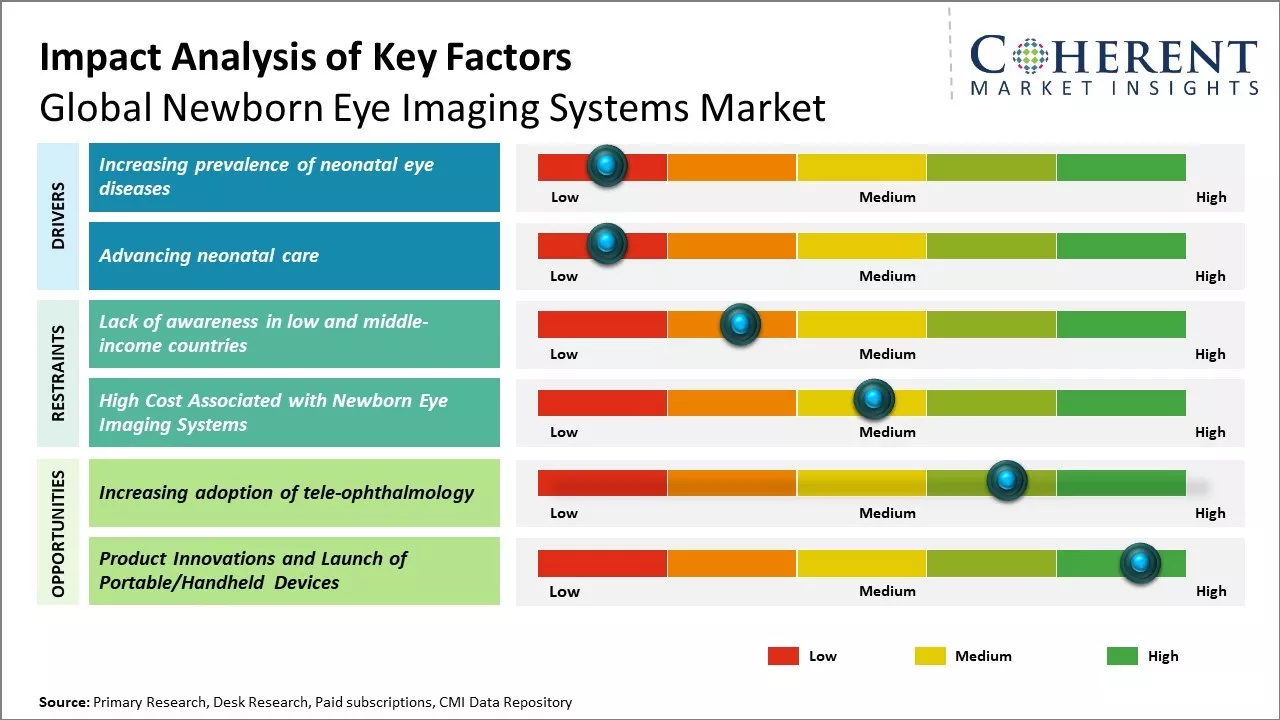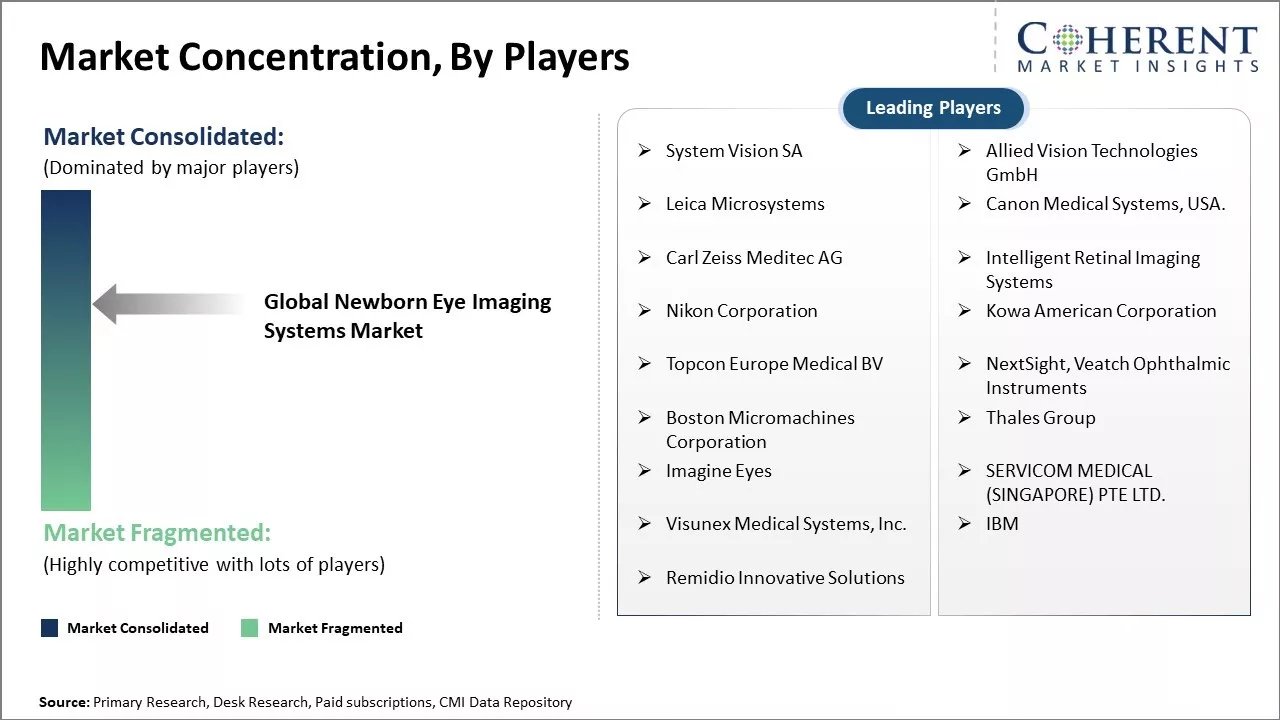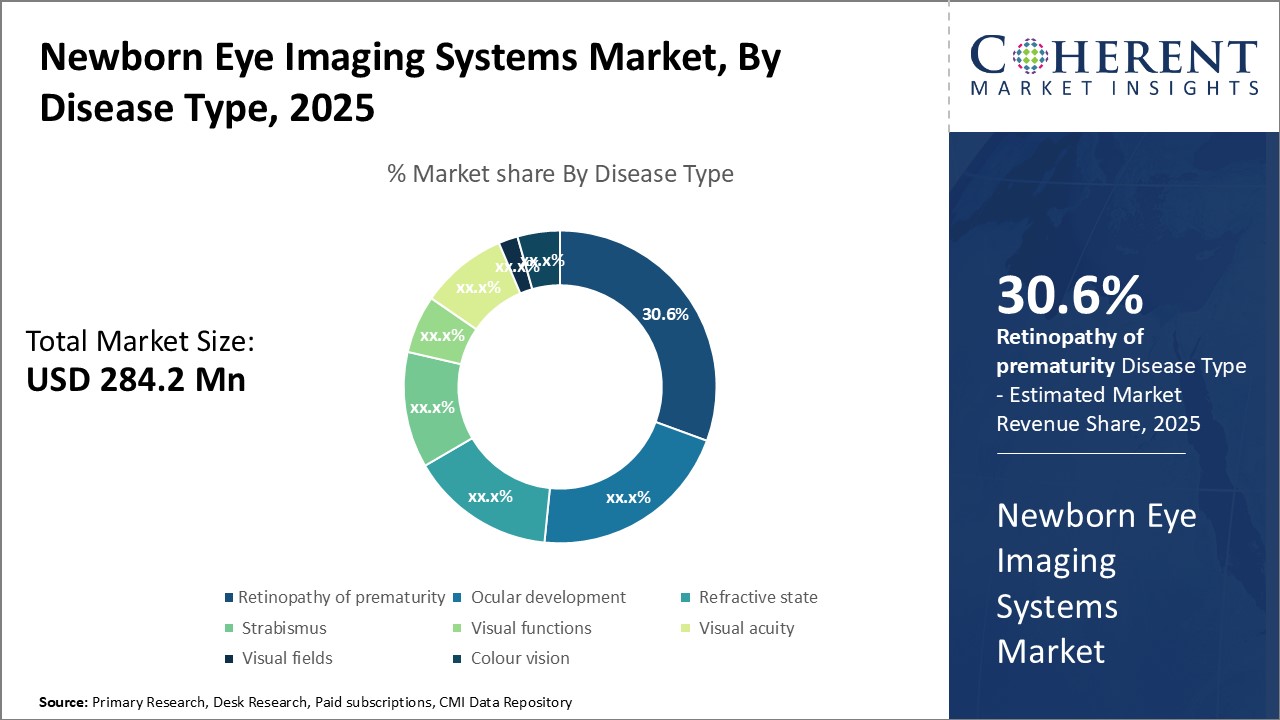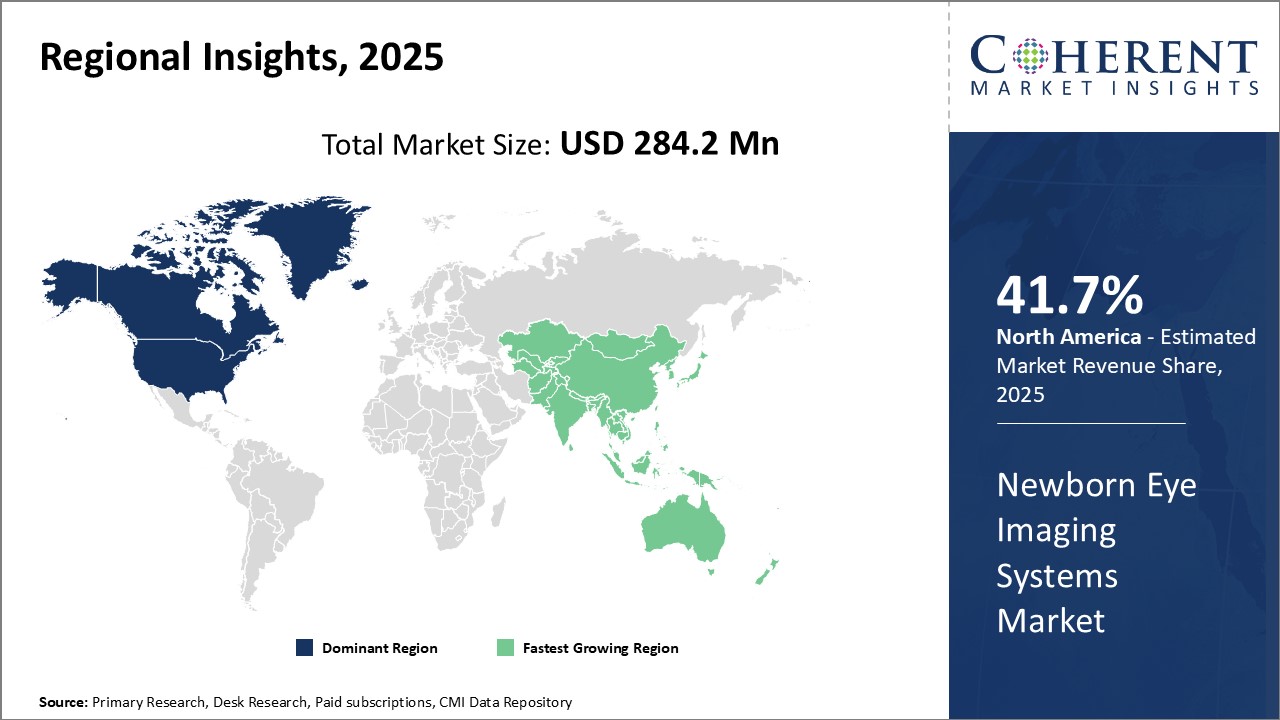Newborn Eye Imaging Systems Market Size and Trends
Global newborn eye imaging systems market is estimated to be valued at USD 284.2 Mn in 2025 and is expected to reach USD 405.5 Mn by 2032, exhibiting a compound annual growth rate (CAGR) of 5% from 2025 to 2032.

Discover market dynamics shaping the industry: Download Free Sample
Newborn eye screening is becoming standard practice in many parts of the world due to rising awareness about sight threatening conditions. This boosts demand for newborn eye imaging systems from hospitals and eye care centers.
Increasing prevalence of neonatal eye diseases
Rising prevalence of various eye diseases among newborns can drive the market growth. In 2020, according to the report published by World Health Organization, more than 1 million newborns worldwide suffer from treatable eye problems every year. The occurrence of retinopathy of prematurity (ROP), which affects premature infants, has doubled in the last two decades due to increasing number of preterm births and improvements in neonatal care. ROP screening is now recommended for all infants born before 30 weeks of gestation or weighing less than or equal to 1500 grams. Moreover, other congenital ocular disorders like cataract, glaucoma and corneal infections can also cause childhood blindness. This rising incidence of neonatal eye diseases has boosted the need for widespread and timely screening of newborns using non-invasive imaging technologies. Newborn eye imaging systems allow early diagnosis of these vulnerable eye conditions, which if left untreated, can cause severe vision impairment or total blindness. These systems offer distinct advantages over manual screening methods as these allow examination of the retina without any risk of infection or additional stress to the fragile newborn. Several specialty hospitals and NICUs are incorporating newborn eye imaging systems as part of their routine screening protocols to reduce the risk of vision loss in children. For Instance, In December 2023, according to the study published by the American Journal of Pathology, granulocyte colony-stimulating factor (G-CSF) plays a significant role in neonatal diseases like bronchopulmonary dysplasia (BPD) and retinopathy of prematurity (ROP). These conditions affect premature infants, with BPD causing lifelong lung damage and ROP leading to irreversible vision impairment. The study found that G-CSF levels were elevated in both mouse models and preterm infants with severe BPD, implicating it in the pathogenesis of these diseases. Mice deficient in G-CSF showed reduced lung damage and protected against retinopathy, suggesting G-CSF as a potential therapeutic target to improve outcomes for premature infants suffering from these conditions.
Market Concentration and Competitive Landscape

Get actionable strategies to beat competition: Download Free Sample
Advancing neonatal care
Ongoing advancement of neonatal care capabilities can boost demand for newborn eye imaging systems. Improvements in medical technology, practices and care settings have enabled the survival of extremely premature infants with very low birth weights. This has led to an increase in ROP cases as more infants are at risk of developing this vision-threatening disease. Healthcare systems and NICUs now have a growing population of high-risk preterm newborns in need of effective screening and monitoring for ROP. Eye imaging technology provides valuable clinical benefits that support the lifesaving work being done in NICUs. Features like non-contact capture of images and remote diagnostic capabilities address core needs of efficiently screening infants at their bedsides. This allows clinical staff to focus on critical neonatal care needs while still providing timely eye screening.
Key Takeaways from Analyst:
Global newborn eye imaging systems market growth is driven by increasing awareness about neonatal eye diseases and visual impairments among parents. Retinopathy of prematurity that can lead to blindness is one of the most common causes of visual impairment in infants. This has boosted the adoption of newborn eye imaging systems for early screening and diagnosis of this disorder. Technological advancements leading to the development of portable and wireless devices allowing screening of infants outside NICUs can also drive the market growth.
North America currently dominates the market, owing to favorable reimbursement policies and growing incidence of eye disorders in newborns. However, Asia Pacific is expected to witness fastest growth due to improving healthcare infrastructure and rising healthcare spending in the region. High birth rates in countries such as China and India also boost regional demand.
High equipment costs can hamper the market growth. Lack of skilled professionals in low-income countries also poses challenge for market growth.
Market Challenges: Lack of awareness in low and middle-income countries
Lack of awareness about newborn eye diseases and their treatment options in low and middle-income countries can hamper the global newborn eye imaging systems market growth. In many developing regions, there is limited understanding among parents, caregivers, and even healthcare professionals about the importance of screening newborn babies for vision-related problems in the early stages. Eye issues in infants often does not show obvious symptoms initially but can lead to serious vision impairment or even blindness, if left untreated. Since these countries have overburdened public health systems and limited resources for advanced medical equipment, newborn eye screenings is typically not prioritized. This lack of awareness leads many cases of preventable or treatable newborn eye conditions go undetected. For instance, according to the World Health Organization, retinopathy of prematurity (ROP), a potentially blinding eye disorder that affects premature infants, affects over 52,000 infants yearly worldwide. However, over 95% of these cases are from low and middle-income nations, where screening programs for ROP are not universally available. If identified early through wide-scale screening facilitated by newborn eye imaging systems, many of these infants could be treated successfully through low-cost interventions like laser therapy or bebinance.
Market Opportunities: Increasing adoption of tele-ophthalmology
Rising adoption of tele-ophthalmology can offer huge opportunity for the newborn eye imaging systems market globally. Tele-ophthalmology or remote diagnosis of eye illnesses using digital medical equipment and telecommunication has gained popularity over the last few years. This has been accelerated due to restrictions imposed during the COVID-19 pandemic when non-essential medical procedures had to be postponed. With tele-ophthalmology, retinal imaging, fundus photography and other vision testing can be carried out remotely by connecting healthcare specialists with patients via internet. This has opened up avenues for screening of newborn babies' eyes across rural and remote areas with limited access to eye care infrastructure and resources. According to the report from WHO, an estimated 19 million infants require examination for retinopathy of prematurity, the leading cause of childhood blindness globally. However, only 50% of these newborns receive appropriate screening due to challenges in accessing specialized eye care facilities, particularly in developing nations. Tele-ophthalmology addresses this unmet need by enabling pediatric retinal examination of babies born prematurely or with low birth weight in their local communities via broadband connectivity and portable newborn eye imaging devices.

Discover high revenue pocket segments and roadmap to it: Download Free Sample
By Disease Type - Early Detection is Key
In terms of disease type, retinopathy of prematurity segment is estimated to contribute the highest market share of 30.6% in 2025, due to importance of early detection for treatment and prevention of blindness. Retinopathy of prematurity (ROP) is a leading cause of childhood blindness worldwide and affects premature infants. Proper screening is required to detect ROP at its early stages when effective treatment can be administered. Newborn eye imaging systems play a vital role in enabling timely screening of at-risk infants. The non-invasive nature of these technologies allows for frequent examinations without causing distress to the vulnerable newborns. This has boosted their adoption by hospitals and ophthalmology clinics for comprehensive screening programs. Moreover, ability of advanced devices to capture high-quality retinal images remotely expands screening access to smaller facilities. The threat of permanent vision impairment underscores the criticality of early detection via newborn eye imaging.
By Device Type - Technological Simplicity Boosts Adoption
In terms of device type, basic device segment is estimated to contribute the highest market share of 60.71% in 2025, owing to their affordability and ease of use. While more sophisticated wireless devices offer advanced features, basic newborn imaging systems are widely used due to their technological simplicity. These entry-level products address the need for affordable solutions in resource-constrained settings and smaller clinics. Their simple plug-and-play design facilitates rapid examination without extensive training. Furthermore, basic devices are portable and require minimal infrastructure. This has boosted their deployment even in rural areas to improve screening coverage. As eye examinations are routinely performed, ease of use and affordability remain key decision factors.
By End User - Critical Role within Healthcare Facilities
In terms of end user, hospital segment is estimated to contribute the highest market share of 40.81% in 2025, owing to the vital functions performed in hospital. As the main treatment hub, hospitals play an indispensable role in newborn and neonatal care. Huge number of at-risk preterm infants are admitted to hospitals for specialized care and screening. Newborn eye imaging systems assist with effective screening programs inside hospital premises, allowing for coordinated management. Their integration with electronic health records also facilitates data monitoring. Furthermore, availability of resources and on-site specialists enable hospitals to establish robust screening protocols. Hospitals engage in public awareness initiatives and outreach to enhance screening coverage.
Regional Insights

Need a Different Region or Segment? Download Free Sample
North America has established itself as the dominant region in the newborn eye imaging systems market with an estimated market share of 41.2 % in 2025. With strong healthcare infrastructure and high awareness about infant care in countries like U.S. and Canada, there has been huge adoption of newborn eye imaging systems in the region. Most of the leading players in newborn eye imaging systems have their headquarters in North America, allowing for strong industry presence and local manufacturing capabilities. Many regional hospitals and clinics have incorporated newborn eye screening as a standard practice.
Stringent newborn health policies and guidelines mandated by government bodies further drives the market growth. North America accounts for the largest share of research and development expenditures in newborn eye imaging technology. Continuous technological advancements introduce new imaging modalities with improved accuracy and workflow.
Asia Pacific has emerged as the fastest growing regional market for newborn eye imaging systems. Countries like China, India and Japan are focusing on preventative healthcare management. Rising healthcare expenditures and expanding medical insurance coverage in Asia has boosted demand for newborn eye screenings. Growing neonatal intensive care units and establishment of specialty children's hospitals also drives the market growth.
Market Report Scope
Newborn Eye Imaging Systems Market Report Coverage
| Report Coverage | Details | ||
|---|---|---|---|
| Base Year: | 2024 | Market Size in 2025: | USD 284.2 Mn |
| Historical Data for: | 2020 To 2024 | Forecast Period: | 2025 To 2032 |
| Forecast Period 2025 to 2032 CAGR: | 5.2% | 2032 Value Projection: | USD 405.5 Mn |
| Geographies covered: |
|
||
| Segments covered: |
|
||
| Companies covered: |
System Vision SA, Sanofi-Aventis LLC., Allied Vision Technologies GmbH, Leica Microsystems, Canon Medical Systems, USA., Carl Zeiss Meditec AG, Intelligent Retinal Imaging Systems, Nikon Corporation, Kowa American Corporation, Topcon Europe Medical BV, NextSight, Veatch Ophthalmic Instruments, Boston Micromachines Corporation, Thales Group, Imagine Eyes, SERVICOM MEDICAL (SINGAPORE) PTE LTD., Visunex Medical Systems, Inc., IBM, Remidio Innovative Solutions |
||
| Growth Drivers: |
|
||
| Restraints & Challenges: |
|
||
Uncover macros and micros vetted on 75+ parameters: Get instant access to report
Newborn Eye Imaging Systems Industry News
- In November 2022, Advancing Eyecare, the leading provider of ophthalmic instruments in North America, announced the acquisition of Veatch Ophthalmic Instruments, a prominent US distributor of ophthalmic equipment.
- In October 2022, ZEISS Medical Technology revealed a strategic partnership with the European Association of Neurosurgical Societies (EANS). This collaboration aims to support the training and continuing education of neurosurgical specialists, foster the exchange of experiences between users and medical technology manufacturers, and advance scientific progress in neurosurgery.
- In July 2022, Meditec partnered with Precise Bio, a regenerative medicine company specializing in bio-printed tissues and organs. Their collaboration focuses on developing and commercializing fabricated corneal tissue for transplants, specifically for patients needing endothelial keratoplasty and natural lenticular transplants to treat conditions like keratoconus and for vision correction.
- In April 2022, Quest Diagnostics, a provider of diagnostic information services, teamed up with IRIS (Intelligent Retinal Imaging Systems) to offer diabetic retinal imaging services at designated Quest Diagnostics patient service centers across the US. This initiative aims to enhance convenience and increase screening rates for diabetic retinopathy, the leading cause of blindness in the United States, particularly for members of population health management programs sponsored by health plans.
*Definition: Newborn Eye Imaging Systems Market involves high-resolution digital imaging technologies used to examine the eyes of newborn babies. These systems help detect common eye problems in infants such as retinopathy of prematurity (ROP), cataracts, glaucoma and other abnormalities. By capturing digital images of the retina, iris and full eyes, eye imaging systems provide neonatologists and pediatric ophthalmologists an efficient and non-invasive way to screen for eye disorders in newborns so that early intervention and treatment can be initiated if needed.
Market Segmentation
- Disease Type Insights (Revenue, USD Mn, 2020 - 2032)
- Retinopathy of prematurity
- Ocular development
- Refractive state
- Strabismus
- Visual functions
- Visual acuity
- Visual fields
- Colour vision
- Device Type Insights (Revenue, USD Mn, 2020 - 2032)
- Basic Device
- Wireless Device
- End User Insights (Revenue, USD Mn, 2020 - 2032)
- Hospital
- Ophthalmology Diagnosis Centre
- Ambulatory Surgical Centre
- Other
- Regional Insights (Revenue, USD Mn, 2020 - 2032)
- North America
- U.S.
- Canada
- Latin America
- Brazil
- Argentina
- Mexico
- Rest of Latin America
- Europe
- Germany
- U.K.
- Spain
- France
- Italy
- Russia
- Rest of Europe
- Asia Pacific
- China
- India
- Japan
- Australia
- South Korea
- ASEAN
- Rest of Asia Pacific
- Middle East
- GCC Countries
- Israel
- Rest of Middle East
- Africa
- South Africa
- North Africa
- Central Africa
- North America
- Key Players Insights
- System Vision SA
- Sanofi-Aventis LLC.
- Allied Vision Technologies GmbH
- Leica Microsystems
- Canon Medical Systems, USA.
- Carl Zeiss Meditec AG
- Intelligent Retinal Imaging Systems
- Nikon Corporation
- Kowa American Corporation
- Topcon Europe Medical BV
- NextSight, Veatch Ophthalmic Instruments
- Boston Micromachines Corporation
- Thales Group
- Imagine Eyes
- SERVICOM MEDICAL (SINGAPORE) PTE LTD.
- Visunex Medical Systems, Inc.
- IBM
- Remidio Innovative Solutions
Share
Share
About Author
Komal Dighe is a Management Consultant with over 8 years of experience in market research and consulting. She excels in managing and delivering high-quality insights and solutions in Health-tech Consulting reports. Her expertise encompasses conducting both primary and secondary research, effectively addressing client requirements, and excelling in market estimation and forecast. Her comprehensive approach ensures that clients receive thorough and accurate analyses, enabling them to make informed decisions and capitalize on market opportunities.
Missing comfort of reading report in your local language? Find your preferred language :
Transform your Strategy with Exclusive Trending Reports :
Frequently Asked Questions
EXISTING CLIENTELE
Joining thousands of companies around the world committed to making the Excellent Business Solutions.
View All Our Clients
